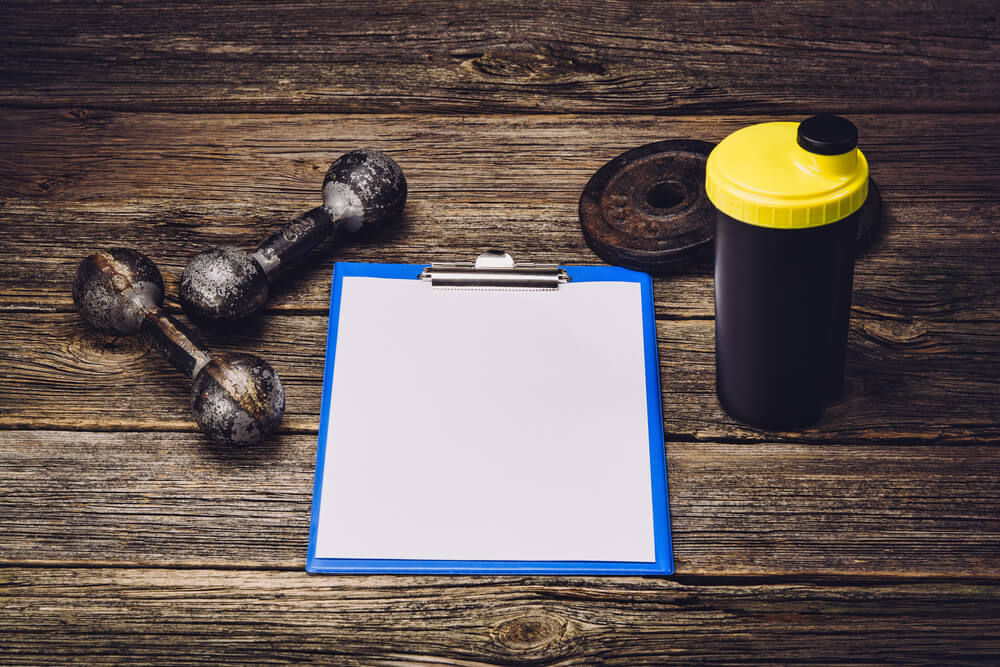Outside of hitting up the gym to meet people (you know, the ones that just kind of linger around the drinking fountain or the elliptical machines), you probably make your way to the local gym for one of three reasons: building muscle strength, you want to build muscle size, or, in the words of Lester Burnham, you “Want to look good naked.”
Thankfully, each one of these three is not excluded from the other.
However, in terms of building size or strength, you’ll need to focus on one.
If building muscle strength is your primary motivation for lifting weights and working out, you’ll need to shift up your workout plan accordingly.
Thankfully, we’ve got all the tips, tricks, and insights you’ll need to do just that.
The Fundamentals of Building Muscle Strength
If you’ve spent any kind of time in the gym, you’ve probably been told the optimal number of reps for any lift is between eight and 12, with two or three sets.
You want to exhaust your muscles between lifting eight and 12 times. If you can lift more, you add weight. If you can’t, you take some weight away. Now, there’s nothing wrong with this approach. If you want to build size, you want to go for this kind of workout. It combines heavier weights and repetition, which in turn tears your muscle fibers more, opening up the potential for larger muscle growth (as long as you supply your body with the necessary proteins).
However, as we established in the intro, building size and building strength require slightly different workout approaches. Increasing your muscle size will help build strength, but as this is not the main goal it won’t be the main end result.
That’s why you need to shift how you lift.
Instead, according to, you want to perform a given lift between four and eight reps. This allows you to increase the amount of weight you lift as you are not lifting the weight as much. This primarily challenges your muscles, instead of primarily tearing the muscle fibers (tearing the muscle fibers will still happen). The weight you lift should realistically be between 80 and 90 percent of your one rep max. In total when counting sets, you want to hit between 10 and 20 total reps.
Splitting Up Reps and Sets
So the goal is to hit between 10 and 20 reps with your target weight. You can shoot for two sets of eight.
However, if you’re able to lift the weight eight times, you should increase the weight.
Realistically four reps per set are ideal as it means your challenging your muscles the most. There are some who will start with a lighter weight (around 80 percent of their one set max) and lift it eight times, move up to 85 percent of their one set max and lift it six times, then push to 90 percent of their one set max and lift it up to four times.
That’s just an example of hitting your 10 and 20 reps per lift.
You might instead go with two or three sets of six reps each, or three to five sets of four reps each. Do what you’re most comfortable with, just keep in mind that the best way to build strength is few reps per set with heavier weights.
Now, if you look around for different weightlifting strength programs, you’ll find that some do have you lifting over 90 percent of your one rep max.
This means you might very well only lift the weight two or three times per set. If you’re lifting super heavy, cap off your reps at 10. This is because when lifting this heavy, you don’t want to overdo it on your joints. Putting up close to 20 reps of your 95 percent one rep max will blast your muscles and drain you, but it will also destroy your joints (not to mention take all sorts of time to finish your workout at the gym).
So if you decide to go really big with huge weight, shoot for no more than 10 reps per exercise.
Increase Rest Time
Your body uses different kinds of muscular energy throughout the day, depending on what you’re doing. It’s why a weightlifter can bench press 400 pounds but becomes winded after running half a mile. Energy used for immediate, explosive moves (such as lifting weights) is expelled quickly. However, the energy used to go the long distance is stretched out. It’s simply about training the body to use these kinds of energies. In scientific terms, it’s known as fast twitch and slow twitch muscles.
Slow twitch fibers use oxygen to energize and take longer to burn out.
This is the muscle type distance and endurance athletes rely on. Fast twitch fibers do not use oxygen but are anaerobically fired off, which provide the explosive move. Because this kind of movement does not rely on oxygen, there is not a continuous flow of fuel, so once the fiber is tired, it takes time to recover (Nerd Fitness, 2010).
So what does all of this fast twitch, slow twitch muscle fibers have to do with improving your strength?
Because you’re lifting big, you will blow through your fast twitch muscle fiber energy extremely quickly.
If you try to rest a minute or so between reps, you’ll have next to no energy for your next set, which reduces the number of times you’ll be able to lift the weight. Instead, you need to increase the amount of time you wait in between reps. This way, you’ll have more fast twitch muscle energy for the lift and, in turn, improve your performance and strength.
According to, if you’re lifting between four and seven reps per set, you want to rest between three and five minutes to help charge your fast twitch muscle fibers back up.
Build Your Workout Around the “Big Four”
Building strength needs to revolve around several core lifts. These lifts will become the focal point of your workout. Basically, you’ll perform these lifts first and then everything else fills in around it. It’s important to perform the major lifts that hit the largest and most muscle groups first. You don’t want to use all of your fast twitch muscle energy on a triceps extension first thing and then have no energy when you move to the bench.
The “Big Four,” is the squat, deadlift, bench press, and shoulder press.
These lifts work the largest muscle groups and the most muscles at once. All other lifts need to be supplemental to these lifts.
Additionally, it’s very important to use barbells. Dumbbells are great when you want to work on every single small stabilizer muscle, but you likely won’t be able to lift as much with dumbbells over a barbell (plus it can be difficult to properly rack up and prep yourself on the squat with dumbbells.
Now, dumbbells can work for some lifts, namely the shoulder press, and you should look to dumbbells for your supplemental lifts, but for maximum weight on the Big Four, look to the barbell.
Beyond the barbells and dumbbells, leave all the other gimmicky and fad equipment on the side of the gym. In terms of sheer strength improvements, nothing beats these lifting methods. And don’t even consider using the Smith machine with a barbell and think it’s the same thing. It’s not. In terms of strength gains, the Smith machine needs to be pushed to the side of the gym as well.
The Smith machine works like a permanent spotter. It also doesn’t allow you to work on the stabilizer muscle groups.
When lifting on the bench press, there are small muscles that kick into action throughout the upper body simply to keep the barbell from tipping.
Those muscles relax and are not engaged on the Smith machine. Sure, you can probably lift a bit more with the Smith machine, but those are artificial numbers. Your goal is pure strength gains, and the best way to boost your strength gains is non-assisted weightlifting.
Lifting Schedule
Here is where it gets a bit tricky.
If you were to ask 20 different fitness instructors, you may hear 20 different lifting schedules. So in reality, you need to go with what works best for you. However, we’ll look at a few of the different, more common lifting schedules.
There’s probably the most commonly used method of breaking it up into upper body and lower body days.
It might be how you lifted back in high school. The idea here is to give one area of your body a day off in between lifting in order to recover and rebuild the damaged muscles. If this works for you fine, but in reality it might be the one you want to avoid. For starters, while you might be able to break down your lower body into one day (you can hit all of your leg muscles with four or five different lifts), your upper body is a bit trickier to hit in one day. Working your back alone requires a few different lifts, as does hitting all the heads of your shoulder, your biceps, neck, and chest. By the time you make it to your smaller muscle groups of the upper body you may not have much energy left.
Plus, working for every muscle group every other day doesn’t give you enough recovery time. If you did decide to go with this, you’d be better off spending Wednesday as an all cardio training day (or a lightweight training, such as cardio with light weights) to give your body ample time to recover.
Realistically, your best options are to break your lifts into three different days. It’s alright if you keep leg day as “leg day,” but with the different muscles groups in your upper body, you might want to break this down into two days. There are a few different theories when it comes to upper body lifts, so we’ll look at two of them.
First, some just break it down into chest/back and shoulders/arms. This is done because when you work one muscle, you’ll also work the opposite muscle. So when you bench press for your chest, the downwards motion works your back.
However, there are others who prefer to break the upper body down into all push movements one day, and all pull movements the other.
This means bench press, shoulder press and other moves that you push the weight away from you would be one day, and then all pull movements, where you pull the weight to you (like curls) is done on an opposite day. There is scientific backing for each lift, so again, just go with what works best for you.
The beauty of breaking up the upper body into two days is you can do one upper body day on Monday, lower body on Tuesday, the other upper body on Wednesday, add in a recovery day, then start again. This gives each area of your body optimal time to recover before being torched again.
Supplements and Diet
You’ll need to fuel yourself with a proper diet. If you were going for size there would be a specific minimum of protein and carbs you should eat. Because you’re going for strength, just make sure you eat throughout the day to keep your metabolism up (every three hours) and consume protein with every meal. You want at least one gram of protein per pound. This way, you can at the very minimum maintain your size.
You want to increase your strength, and one of the best ways to do this is with supplements. Creatine is a must here. Creatine is naturally produced in your body and helps with the fast twitch muscle fibers, but it’s quickly used up.
By taking creatine supplements (make sure to follow the recommended dosage) you’ll help replenish this in your body, which in turn helps your muscles recover faster and squeeze off additional reps.
In Conclusion
If you’re looking to gain strength, it’s all about lifting big and giving your body the time to recover.
Lifting for strength gains is different from lifting for size and weight loss, so make sure you really stick with it. It will put extra strain on your body, but you’ll see faster strength gains than ever before. Just make sure to be mindful of what your body is telling you. If something doesn’t feel right, or if your body is sore in joints (not the regular muscle soreness), see your doctor.
It’s best to identify any possible issues and adjust your weight lifting accordingly sooner rather than later.
Terry Asher
Latest posts by Terry Asher (see all)
- Better Family – Product Review Liquid Daily 2 oz - Dec 16, 2024
- Post-Workout Recovery: The Key to Optimal Performance - Nov 25, 2024
- Pre-Workout Supplements – Everything You Need To Know - Nov 18, 2024














[…] via- https://gymjunkies.com/building-muscle-strength/ […]
[…] beginning with 15 lbs. For those who begin heavy you threat burning out too quickly. You have to build up your strength. Don’t stress out if you happen to’re a pair kilos greater or decrease than 15 […]
[…] of Bodybuilding, Arnold confesses to the start as a power-lifter and mentioned it gave him the “thickness“. His basic work additionally references scientific research proving that compound actions with […]
[…] of Bodybuilding, Arnold confesses to the beginning as a power-lifter and said it gave him the “thickness“. His classic work also references scientific studies proving that compound movements with free […]
[…] to help improve functionality and boost mobility of your entire body, which in turn will help improve your strength and […]
[…] some people can work up to a higher platform to build more strength, most people are limited as to how far they can go. To figure out your maximum platform size, […]
[…] past decades, there have been many strength-building programs. Every gym-goer wants hypertrophy, of course, but it seems like there’s a little too […]
[…] past decades, there have been many strength-building programs. Every gym-goer wants hypertrophy, of course, but it seems like there’s a little […]
[…] past decades, there have been many strength-building programs. Every gym-goer wants hypertrophy, of course, but it seems like there’s a little too […]
[…] past decades, there have been many strength-building programs. Every gym-goer wants hypertrophy, of course, but it seems like there’s a little too […]
[…] secret to building muscle mass extends well beyond our mealtimes themselves: It’s more about what we eat—rather than when […]
[…] Building up strength in your upper body is a good way to prevent injuries for any active person. If you need additional guidance to do a floor press correctly, a personal trainer can help you. […]
[…] the second week, but if you have reached the expectations you had for the second week, that is an accomplishment. And if you are consistently meeting your expectations and producing results, being consistent […]